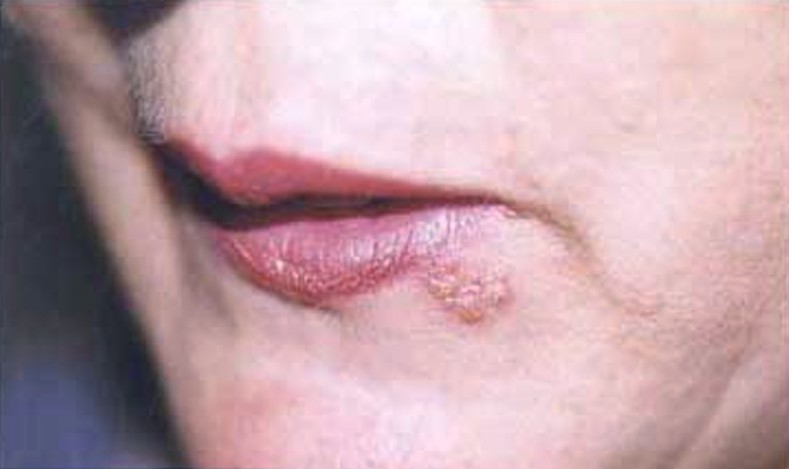Cold Sores, also referred to as fever blisters, are tiny lesions that are filled with clear fluid. These are most frequently reported near the oral cavity (especially around the lips) and are usually found in group like lesions. Once these blisters or sores are burst, a crust like residue is usually formed which eventually heals within two-week time period.
It is imperative to mention that cold sores are caused by viral agent – Herpes Simplex virus (or HSV). There are two varieties of this virus; type 1 is responsible for causing fever blister whereas type 2 is mainly implicated as a causative agent for blisters on the genital areas. Due to viral association, the cold sore can spread to uninfected normal individuals via close physical contact with the blister fluid. This condition has no cure; however, it does get better with the use of antiviral agents. Most people report the recurrence of these lesions with moderate exposure to stress or in the setting of weak immune system.
Are There Any Other Cold Sore Symptoms?

Cold sores tend to cause localized lesions in the distinct areas of skin. Moreover, the sores follows a predictable course with varying intensity of involvement in different individuals. The symptomatology is highly variable, with some individuals showing no symptom at all while others experiencing mild illness. In most cases, signs of initial outbreak of lesions becomes evident within 3 weeks of viral exposure. The lesions resolve spontaneously within a few weeks without requiring any treatment. However, in case of any viral reactivation, the lesions may return abruptly.
Most frequently reported symptoms of cold sore are:
- Itching and tingling sensations: Before the appearance of lesions the skin around the affected area becomes a little itchy with or without paresthesia or tingling sensation.
- Formation of blisters: Blisters are formed on the adjoining area where skin and lips fuses together. Initial lesions are tiny and filled with fluid. These blisters can also emerge around nose and cheeks.
- Crusting and oozing: These tiny blisters join together to form clusters of blisters. When these blisters break, the clear inflammatory fluid of lesions form a crust before disappearing completely.
First-Time Outbreak Symptoms
Most people who get affected with herpes simplex virus do not experience any symptoms, but some may experience discomfort and pain during active infection. Initially this infection is followed by formation of tiny sores that are filled with fluid as discussed above. These lesions are reddish or purplish in color and are most concentrated near the periphery of lips and mouth. Within a short period of time, these lesions amalgamate and burst to form crusty lesions. In some cases, associated symptoms like fever, moderate headache, general body aches, muscle aches, sore throat and swollen neck glands are also reported.
Children below 5 years of age also develop cold sore within their oral cavity. Often these lesions are misunderstood as canker sores. Young children are more vulnerable to spread this viral agent to other parts of their body due to immature immune system.
Symptoms of Cold Sore Recurrence
Once the body is infected by this virus, the person is vulnerable to develop recurrent episodes due to virus reactivation. Human body cannot completely overcome this virus which stays in the body in the state of dormancy. In some individuals, the virus permanently stays there without showing any signs of its presence; while in other cases, it may show exacerbations.
Before any such viral reactivation event, the affected person usually predicts the exacerbation due to prodromal symptoms like feeling of itching and tingling sensation. This reappearance of cold sore is regarded as recurrent. The secondary cold sores appear on nostrils, mouth, lips and even on cheeks and chin. The frequency of recurrent cold sore is 4-5 times in a year and each episode usually lasts for 4-10 days.
When to See a Doctor
Cold sore usually doesn’t require medical treatment. However doctor’s advice can be taken if following problem occurs:
- If irritation or inflammation involve visual apparatus
- The healing time is prolonged
- If cold sores appear very often
- Your immune system is incompatible due to congenital or acquired lesion
Triggers and Prevention of Cold Sore Recurrence
Common Triggers of Cold Sore Recurrence
- Poorly developed immune system
- Hormonal changes in female body during menstrual or ovarian cycles
- Personal history of facial surgery
- Any dental procedure
- In case of allergic reaction to certain foods
- In the setting of stressful events like infections (such as flu and common cold)
- Fatigue or stress
- Exposure of sunlight rays
Preventions of Cold Sore Recurrence
If a person is suffering from cold sore, it is advised to protect others from it. For this purpose some preventive measures can be taken:
- Do not engage in oral sex or kissing activity until you are completely recovered.
- Don’t share objects that are used on your body such as towels, glass, razor, lipsticks, etc.
- Make sure that you wash your hands after making a contact with your lesions otherwise it might spread to the rest of your body.
- Use disposable papers after you wash your face.
Here is an article telling some possible treatment options for cold sores: http://www.just-health.net/Cold-Sore-Treatment.html
